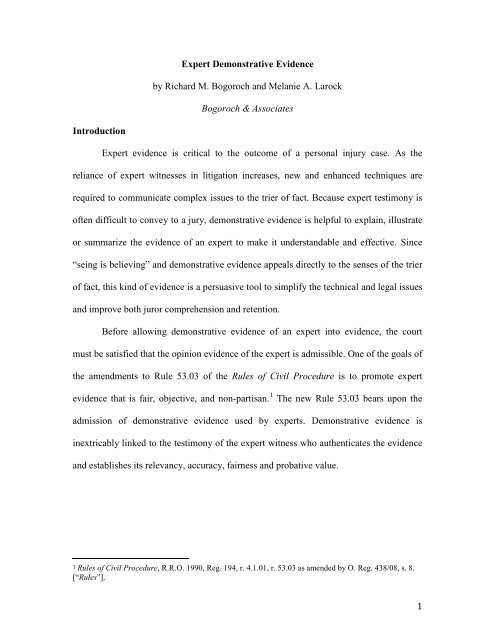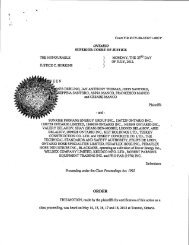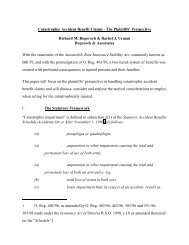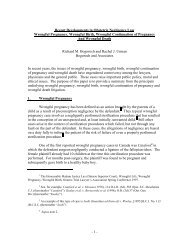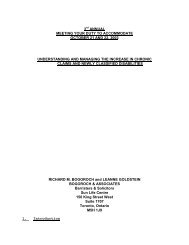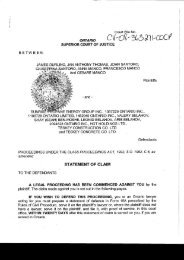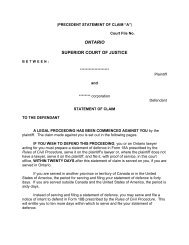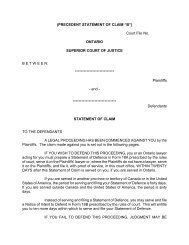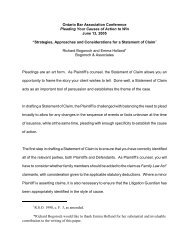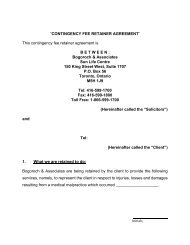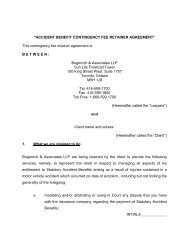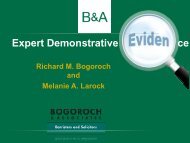Expert Demonstrative Evidence - Bogoroch & Associates
Expert Demonstrative Evidence - Bogoroch & Associates
Expert Demonstrative Evidence - Bogoroch & Associates
Create successful ePaper yourself
Turn your PDF publications into a flip-book with our unique Google optimized e-Paper software.
<strong>Expert</strong> <strong>Demonstrative</strong> <strong>Evidence</strong><br />
by Richard M. <strong>Bogoroch</strong> and Melanie A. Larock<br />
<strong>Bogoroch</strong> & <strong>Associates</strong><br />
Introduction<br />
<strong>Expert</strong> evidence is critical to the outcome of a personal injury case. As the<br />
reliance of expert witnesses in litigation increases, new and enhanced techniques are<br />
required to communicate complex issues to the trier of fact. Because expert testimony is<br />
often difficult to convey to a jury, demonstrative evidence is helpful to explain, illustrate<br />
or summarize the evidence of an expert to make it understandable and effective. Since<br />
“seing is believing” and demonstrative evidence appeals directly to the senses of the trier<br />
of fact, this kind of evidence is a persuasive tool to simplify the technical and legal issues<br />
and improve both juror comprehension and retention.<br />
Before allowing demonstrative evidence of an expert into evidence, the court<br />
must be satisfied that the opinion evidence of the expert is admissible. One of the goals of<br />
the amendments to Rule 53.03 of the Rules of Civil Procedure is to promote expert<br />
evidence that is fair, objective, and non-partisan. 1 The new Rule 53.03 bears upon the<br />
admission of demonstrative evidence used by experts. <strong>Demonstrative</strong> evidence is<br />
inextricably linked to the testimony of the expert witness who authenticates the evidence<br />
and establishes its relevancy, accuracy, fairness and probative value.<br />
1 Rules of Civil Procedure, R.R.O. 1990, Reg. 194, r. 4.1.01, r. 53.03 as amended by O. Reg. 438/08, s. 8.<br />
[“Rules”].<br />
1
Admissibility of <strong>Demonstrative</strong> <strong>Evidence</strong> used by <strong>Expert</strong>s<br />
<strong>Demonstrative</strong> evidence is often adduced to help explain expert evidence. It<br />
supplements an expert’s opinion evidence to assist the trier of fact to understand evidence<br />
outside of his or her range of experience so that a correct conclusion on the evidence can<br />
be reached.<br />
Since the types of demonstrative evidence and the purposes for which it is<br />
introduced are extremely varied, it is completely within the discretion of the trial judge in<br />
ruling upon the admissibility of demonstrative evidence. 2 A few general principles apply<br />
to the law of demonstrative evidence. The demonstrative evidence must be: i) relevant; ii)<br />
accurate and fair; iii) the probative value must outweigh any prejudicial effect of the<br />
evidence; iv) the demonstrative evidence must not offend any exclusionary rule; and v) it<br />
would be of assistance to the court.<br />
The general rule regarding the admissibility of evidence is that evidence that is<br />
relevant to a material issue is admissible unless it is caught by an exclusionary rule or<br />
unless the prejudicial effect outweighs its probative value. A trial judge exercises a<br />
gatekeeper role and uses discretion to consider the value of the evidence, based on both<br />
its reliability and the strength of the inferences it leads to, against the costs presented by<br />
the evidence, including the practicalities of its presentation, the fairness to the parties and<br />
to witnesses, and the potentially distorting effect the evidence can have on the outcome of<br />
the case.<br />
3<br />
In Sopinka, Lederman & Bryant: The Law of <strong>Evidence</strong> in Canada, 3rd ed.<br />
(Markham: Lexis Nexis, 2009), authors Bryant, Lederman, Letterman & Fuerst write at s.<br />
2 Draper v. Jacklyn, [1970] S.C.R. 92.<br />
3 Whilby v. Redhead, [2010] O.J. No. 1820 at para. 2.<br />
2
12.126:<br />
The proponent of the expert evidence must satisfy the trial judge<br />
that the proffered expert witness acquired special or peculiar<br />
knowledge through study or experience in respect of the subject<br />
matter of the opinion. The witness' expertise must be in the<br />
particular field in which the witness' opinion is sought and the<br />
expert's evidence should be confined to her or his area of<br />
expertise to minimize its potential for misuse or confusion. The<br />
admissibility of expert evidence does not depend upon the means<br />
by which that skill was acquired. As long as the trial judge is<br />
satisfied that the witness is sufficiently experienced in the subject<br />
matter at issue, the judge will not be concerned with whether the<br />
expertise was derived from specific studies or by practical<br />
training, although that may affect the weight to be given to the<br />
evidence. 4<br />
For demonstrative evidence to be admissible, the expert evidence that it exists to<br />
explain and illustrate must also be admissible. The Supreme Court of Canada in R. v.<br />
Mohan (1994), 114 D.L.R. (4 th ) 419 identifies four pre-conditions for the admission of<br />
expert evidence: i) relevance; ii) necessity in assisting the trier of fact; iii) the absence of<br />
any exclusionary rule; and iv) a properly qualified expert.<br />
Mr. Justice Doherty in R. v. Abbey, [2009] O.J. No. 3534 proposed a two-step<br />
process for determining the admissibility of an expert opinion:<br />
1. The evidence must meet the four prerequisites of admissibility of expert evidence<br />
as identified in R v. Mohan, which is a rules based analysis.<br />
2. The trial judge must decide whether the expert evidence that meets the preconditions<br />
is sufficiently beneficial to the trial process to warrant its admission<br />
despite the potential harm to the trial process that may flow from the admission of<br />
the expert evidence. This is the gatekeeper inquiry.<br />
In addition to the above requirements for admissibility, an expert witness must<br />
have prepared a Rule 53.03 compliant report and acknowledged that they owe a duty to<br />
4 Bryant, Lederman, Letterman & Fuerst, “Sopinka, Lederman & Bryant: The Law of <strong>Evidence</strong> in Canada,<br />
3 rd Edition.” (2009). Markham: Lexis Nexis.<br />
3
assist the court with opinion evidence that is fair, objective and non-partisan. Therefore,<br />
the first step proposed by Mr. Justice Doherty would also include statutory compliance<br />
with Rule 53.03, which provides for the following requirements for an expert report:<br />
(a) The expert’s name, address and area of expertise;<br />
(b) The expert’s qualifications and employment and educational experiences in<br />
his or her area of expertise;<br />
(c) The instructions provided to the expert in relation to the proceeding;<br />
(d) The nature of the opinion being sought and each issue in the proceeding to<br />
which the opinion relates;<br />
(e) The expert’s opinion respecting each issue and, where there is a range of<br />
opinions given, a summary of the range and the reasons for the expert’s own<br />
opinion within that range;<br />
(f) The expert’s reasons for his or her opinion, including, a description of the<br />
factual assumptions on which the opinion is based, a description of any research<br />
conducted by the expert that led him or her to form the opinion, and a list of every<br />
document, if any, relied on by the expert in forming the opinion; and,<br />
(g) An acknowledgement of expert’s duty under Rule 4.1 signed by the expert. 5<br />
Rule 53.03 goes on to provide that an expert witness may not testify with respect<br />
to an issue, except with leave of the trial judge, unless the substance of his or her<br />
testimony with respect to that issue is set out in a Rule 53.03 compliant report. If an<br />
expert report contains a reference to a demonstrative aid or it is intended that the expert<br />
witness shall refer to a demonstrative aid that can be considered to be a “document”,<br />
opposing counsel should be given an opportunity to review the demonstrative evidence.<br />
The gatekeeper inquiry consists of a cost-benefit analysis, which is case-specific.<br />
The "benefit" side of the evaluation requires a consideration of the probative potential of<br />
the evidence and the significance of the issue to which the evidence is directed. When<br />
one looks to potential probative value, one must consider the reliability of the evidence.<br />
5 Rules, supra note 1, r. 53.03 as amended by O.Reg. 438/08, s. 48.<br />
4
Reliability concerns reach not only the subject matter of the evidence, but also the<br />
methodology used by the proposed expert in arriving at his or her opinion, the expert's<br />
expertise, the language used in explaining the opinion and the extent to which the expert<br />
is shown to be impartial and objective.<br />
The "cost" side of the ledger addresses the various risks inherent in the<br />
admissibility of expert opinion evidence, described succinctly by Binnie J. in J.-L.J. at<br />
para. 47 as "consumption of time, prejudice and confusion". There is a risk that a jury<br />
may abdicate its fact-finding role. <strong>Expert</strong> opinion evidence can also compromise the trial<br />
process by unduly protracting and complicating proceedings. Circumstances in which a<br />
judge in a civil case would exclude demonstrative evidence because of its inflammatory<br />
nature should be rare because of our regular exposure to popular media.<br />
observations:<br />
In McCormick on <strong>Evidence</strong>, (5th) ed., Volume 2, the authors make the following<br />
Again, even if no essentially emotional response is likely to result,<br />
demonstrative evidence may convey an impression of objective reality to the<br />
trier. Thus, the courts are frequently sensitive to the objection that the<br />
evidence is misleading,' and zealous to insure that there is no material<br />
differential between objective things offered at trial and the same or<br />
different objective things as they existed at the time of the events or<br />
occurrences in litigation.<br />
…<br />
A still different set of problems is presented by photographs or videotapes<br />
which do not portray original facts in controversy, but rather represent one<br />
party's staged reproduction of those facts. Here the extreme vividness and<br />
verisimilitude of pictorial evidence is truly a two-edged sword. For not only<br />
is the danger that the jury may confuse art with reality particularly great, but<br />
the impressions generated by the evidence may prove particularly difficult<br />
to limit or, if the film is subsequently deemed inadmissible, to expunge by<br />
judicial instruction. The latter difficulty may be largely eliminated by a<br />
preliminary viewing by the court in chambers, and the decided cases suggest<br />
that this expedient is widely employed. 6<br />
6 Strong, Brown, Dix, Imwinkelried, Kaye, Mostellen and Roberts, “McCormick on <strong>Evidence</strong>, 5 th Ed.,<br />
Volume 2.” (1999) West Publishing Co. at pp. 17-19.<br />
5
The cost-benefit analysis demands a consideration of the extent to which the<br />
opinion evidence is necessary to a proper adjudication of the facts to which that evidence<br />
is directed. <strong>Expert</strong> opinion evidence that brings no added benefit to the process will be<br />
excluded. Opinion evidence that is essential to a jury's ability to understand and evaluate<br />
material evidence will register high on the "benefit" side of the scale. Arguably,<br />
demonstrative evidence ought to register as a benefit to the judicial process by facilitating<br />
the trier of fact’s understanding of complicated expert evidence.<br />
In Jenkyns v. Kassam, [2006] O.J. No. 5494, the Court held that in order to rely<br />
on demonstrative evidence by an expert, a proper foundation must be established:<br />
1. The expert’s testimony is relevant and admissible and the demonstrative aid<br />
relates to the evidence;<br />
2. The expert whose testimony the demonstrative aid depicts is familiar with it;<br />
3. The demonstrative aid fairly and accurately reflects the expert’s evidence to<br />
which it relates; and<br />
4. The demonstrative aid will aid the trier of fact in understanding or<br />
evaluating the expert’s evidence. 7<br />
The introduction of demonstrative evidence must be done in a manner that will<br />
ensure the integrity of the evidence so tendered. 8<br />
<strong>Demonstrative</strong> evidence must be<br />
accurate, fair and not misleading. The foundational information upon which the<br />
demonstrative evidence is based ought to be presented to the court to aid in the<br />
understanding of the evidence. For example, for a medical illustration to be admitted into<br />
evidence, there must be oral evidence to confirm that it is an accurate and fair depiction<br />
of what it purports to show. For a computer reconstruction animation to be admitted,<br />
“overall it must be proven that the procedures used to feed the data into the computer<br />
7 Jenkyns v. Kassam, [2006] O.J. No. 5494 at para. 5.<br />
8 Greer (Litigation Guardian of) v. Kurtz, [2008] O.J. No. 2925 at para. 10.<br />
6
were reliable and that someone checked the accuracy of the data and the computer<br />
operations.” 9<br />
Owens (Litigation Guardian of) v. Grandell [1994] O.J. No. 496, 46 A.C.W.S.<br />
(3d) 796 (Gen. Div.) is the leading case regarding the admissibility of computer<br />
animations in Ontario. A computer-generated animation depicted the engineer’s<br />
reconstruction of the accident. During the testimony of the accident reconstruction expert,<br />
the process of obtaining the measurements, distances and other foundational information<br />
were explained, as well as the process of data entry. Kozak J. outlined the requirements<br />
for what would need to be proven for the admissibility of a computer-generated<br />
reconstruction animation to support and compliment the evidence of an engineer:<br />
(1) From the testimony from the accident reconstruction expert that the data<br />
points measured at the accident site were accurately recorded.<br />
(2) From the testimony of the person who entered those data points into the<br />
program that they were entered correctly.<br />
(3) That the algorithms used in the form and motion software validly apply<br />
the law of physics and validly render accurate images of the scenes depicted<br />
in the exhibit.<br />
(4) Competent opinion testimony from the accident reconstruction expert that<br />
any additional modifications to the exhibit, made after the computer's first<br />
renderings, are valid.<br />
(5) Testimony that the experts are familiar with the demonstrative exhibit.<br />
(6) A showing that the exhibit will aid the trier of fact in understanding the<br />
expert's testimony.<br />
In Lancaster (Litigation Guardian of) v. Santos, [2011] O.J. No. 3706, the<br />
engineer’s calculations for the animation were not provided to the court. It was not<br />
9 Owens (Litigation Guardian of) v. Grandell [1994] O.J. No. 496, 46 A.C.W.S. (3d) 796 (Gen. Div.).<br />
7
proven that the data was reliable or accurate. The animation was inadmissible and the<br />
expert’s opinion was rejected.<br />
By contrast, in Greer (Litigation Guardian of) v. Kurtz, 10<br />
both the accident<br />
reconstruction engineer and the forensic animator testified to the accuracy of the<br />
animations depicting the accident reconstruction. Justice B.H. Matheson was satisfied<br />
that “all the safeguards had been met.” The animation was based on photos,<br />
measurements, final resting positions and other physical data that was explained to the<br />
court. Other safeguards include cross-examination and the right of the other party to<br />
adduce its own evidence to criticize the demonstrative evidence. In Greer, the animation<br />
was of assistance to the court and therefore admitted.<br />
Guidelines for the effective use of demonstrative evidence<br />
In Geoffrey D.E. Adair’s article, The Uses and Abuses of <strong>Demonstrative</strong><br />
<strong>Evidence</strong>, he outlines useful guidelines: 11<br />
1. Place a reasonable limit on the number of demonstrative aids employed.<br />
The cumulative effect of too many of demonstrative aids may create the<br />
impression that your case is superficial.<br />
2. Avoid undue use of those aids you do employ. Over-exposure of the<br />
demonstrative aid tends to lessen its impact.<br />
3. Use carefully prepared “professional looking” aids.<br />
4. Employ sing-message demonstrative aids.<br />
5. <strong>Demonstrative</strong> aids ought to be tendered in keeping with the natural and<br />
regular flow of the case.<br />
6. Make sure that copies of the visual material are available for the trier of<br />
fact, or at least the material is readily visible.<br />
10 Supra, note 5.<br />
11 Geoffrey D.E. Adair “The Uses and Abuses of <strong>Demonstrative</strong> <strong>Evidence</strong>” at pp. 365-377. The Law<br />
Society of Upper Canada Special Lectures 2003: The Law of <strong>Evidence</strong>.<br />
8
7. Finally, make sure that demonstrative aids are only used in circumstances<br />
where they will truly be effective in imparting a strong message or leaving<br />
an impact upon the trier of fact. It is counterproductive to use a<br />
demonstrative aid for the sake of attempting to be a modern advocate,<br />
when the aid itself adds nothing.<br />
Conclusion<br />
Much has been written about the efficacy of demonstrative evidence at trial.<br />
<strong>Demonstrative</strong> evidence is an important tool of persuasion. It can simplify a complex<br />
subject through the use of visual aids and is more memorable than the spoken word.<br />
<strong>Demonstrative</strong> evidence can prevent boredom and renew interest.<br />
The admissibility of an expert’s demonstrative evidence is inextricably connected<br />
with the admissibility of the opinion evidence of the expert. The principles of fair,<br />
objective and non-partisan expert evidence will also be applied to the admissibility of<br />
demonstrative evidence used to assist experts in the presentation of their evidence.<br />
<strong>Demonstrative</strong> evidence can enhance the efficiency of the litigation process by explaining<br />
complicated or lengthy evidence, enhancing the retention of information by the jury and<br />
focusing testimony; thereby, enhancing the ability of the trier of fact to come to a<br />
conclusion.<br />
9
Appendix<br />
Forms of <strong>Demonstrative</strong> <strong>Evidence</strong><br />
Photographs<br />
Draper v. Jacklyn (1970), 9 D.L.R. (3d)<br />
264 (S.C.C.):<br />
Photographs may be admitted if:<br />
1) they are relevant;<br />
2) they assist the jury’s understanding<br />
of the treatment and condition of<br />
the plaintiff;<br />
3) the photographs are accurate; and<br />
4) the prejudicial effect of the<br />
photographs is not so great that it<br />
would exceed the probative value.<br />
Video Tapes Teno v. Arnold (1974), 7 O.R. (2d) 276:<br />
“day in the life” video<br />
The test to be applied in considering the<br />
admission of videotape and photographs is<br />
the same: Rodger v. Strop (1992), 14<br />
C.P.C. (3d) 289.<br />
R. v. Nikolovski (1994), 19 O.R. (3d) 676<br />
(Ont. C.A.) approved following test for<br />
admissibility of video tapes:<br />
1) the accuracy of the tapes in truly<br />
representing the facts;<br />
2) their fairness and absence of intention to<br />
mislead; and<br />
3) their verification on oath by a person<br />
capable of doing so.<br />
Treatment chronologies Calic v. Aitchison et al, [1996] O.J. No.<br />
154 (Gen. Div.). Justice Hockin stated at<br />
para. 19, “Mr. Calic’s medical history since<br />
the accident is lengthy and complicated.<br />
Counsel for Mr. Calic usefully summarized<br />
the history by tracing Mr. Calic’s five year<br />
journey from one specialist to another in<br />
documentary form (Exhibit 5).”<br />
Computer Generated Animations Owens v. Grandell, [1994] O.J. No. 496<br />
(see above)<br />
10
McCutcheon v. Chrysler Canada Ltd.,<br />
[1998] O.J. No. 5818 stated criteria for<br />
admissibility:<br />
1) the computer animation is relevant<br />
to the issues in the proceeding;<br />
2) the hardware and software methods<br />
employed by the animator are<br />
verified by the animator;<br />
3) the computer animation does not<br />
contain editorial comments other<br />
than the usual headings;<br />
4) the computer animation accurately<br />
represents the plaintiff’s condition;<br />
5) the computer animation is necessary<br />
considering that it would be<br />
difficult for a witness to describe<br />
the effects of the injury and the<br />
jury’s understanding of the issues<br />
would be greatly assisted by the<br />
animation;<br />
6) the prejudicial value does not<br />
outweigh the probative value<br />
considering that the animation is<br />
presented in a way very simple<br />
straightforward manner, without<br />
sound or editorializing and with few<br />
headings; and<br />
7) the presentation was not misleading<br />
or unfair to the defendant.<br />
Cejvan v. Blue Mountain Resorts<br />
Limited,[2008] O.J. No. 5443: threedimensional<br />
computer model of the ski run<br />
used by the plaintiff. The animation was<br />
accepted only for the limited purpose of<br />
showing the general topography of the<br />
area. L.C. Templeton J. was critical of the<br />
animation because it lacked accuracy,<br />
relied upon too many unknown factors and<br />
was prejudicial.<br />
Anatomical illustrations or models Majencic v. Natale, [1968] 1 O.R. 189<br />
(H.C.J.)<br />
Jenkyns v. Kassam, [2006] O.J. No. 5494<br />
11
Power Point Presentations R. v. Sandham (2009), Carswell Ont 6592<br />
(S.C.J.): admissible<br />
R. v. Paul (2004), Carswell Ont 1256:<br />
inadmissible<br />
12


